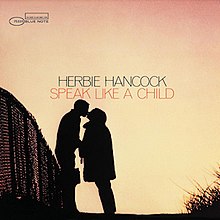Speak Like a Child (album)
| Speak Like a Child | ||||
|---|---|---|---|---|
 |
||||
| Studio album by Herbie Hancock | ||||
| Released | Summer 1968 | |||
| Recorded | March 6 and 9, 1968 Van Gelder Studio, Englewood Cliffs |
|||
| Genre | Hard bop, jazz | |||
| Length | 37:05 original LP | |||
| Label |
Blue Note BST 84279 |
|||
| Producer | Duke Pearson | |||
| Herbie Hancock chronology | ||||
|
||||
| Professional ratings | |
|---|---|
| Review scores | |
| Source | Rating |
| Allmusic | |
| The Rolling Stone Jazz Record Guide | |
Speak Like a Child is the sixth album by American jazz pianist Herbie Hancock, recorded and released by Blue Note Records in 1968. Featuring Hancock's arrangements for an unusual front line of alto flute, bass trombone and flugelhorn, the album was described by critic Nat Hentoff as an "impressive further stage in the evolution of Herbie Hancock as writer and player", characterised by a "singular quality of incisive, searching lyricism."
The evocative cover photograph was taken by David Bythewood, an acquaintance of Hancock. The photo depicts Hancock in silhouette kissing his then-girlfriend, Gigi Meixner.
The pianist wanted to represent here a childlike, but not childish, philosophy. He felt this music didn't reflect the social turmoil of the late 1960s in America, that is riots and problematic economy. Hancock rather wanted to picture a more upbeat, brighter future, or, as he says, "a forward look into what could be a bright future." More so, Hancock wanted to go back and rediscover certain childhood qualities "we lose and wish we could have back - purity, spontaneity. When they do return to us, we're at our best." Therefore, "Speak Like a Child" translates as "think and feel in terms of hope, and the possibilities of making our future less impure".
In the liner notes, Hancock further points out his approach to the album, recalling his previous efforts: "What I was into then, and have been thinking about more and more, was the concept that there is a type of music in between jazz and rock." In fact, in 1966 Hancock tried to record a funk album with a nine-piece ensemble, attempt that failed and never made it to release: "I was trying to make a funk record without knowing a thing about funk." Hancock also referred to himself as a "jazz snob" and stated the date didn't turn out as he expected.
"This album is an extension of Maiden Voyage in terms of use of simple, singable melodies. I've been trying for a long time to work on swinging, and of all the albums I've done, this to me swings the most. [...] What's different in Speak Like a Child as a whole has to do, first, with harmony. For the most part, the harmonies in these numbers are freer in the sense that they're not so easily identifiable chordally in the conventional way. I'm more concerned with sounds than chords, and so I voice the harmonies to provide a wider spectrum of colors that can be contained within the traditional chord progression. [...] Similarly, in those tracks with the horns, I was more interested in sounds than in definite chord patterns. I tried to give the horns notes that would give color and body to the sounds I heard as I wrote." Hancock says this way of thinking partially came from listening to Gil Evans, Oliver Nelson and Thad Jones. Also, the pianist was becoming really captivated by ensembles. Indeed, he concludes saying "certainly, one of the ways I'm going to go from here on is writing for large groups [...] I feel I have to go on and write more for horns, explore more possibilities of textures." More recently, Hancock commented "Once I made that album, there was no doubt in my mind that, when I organized my own band, it would be a sextet."
...
Wikipedia
